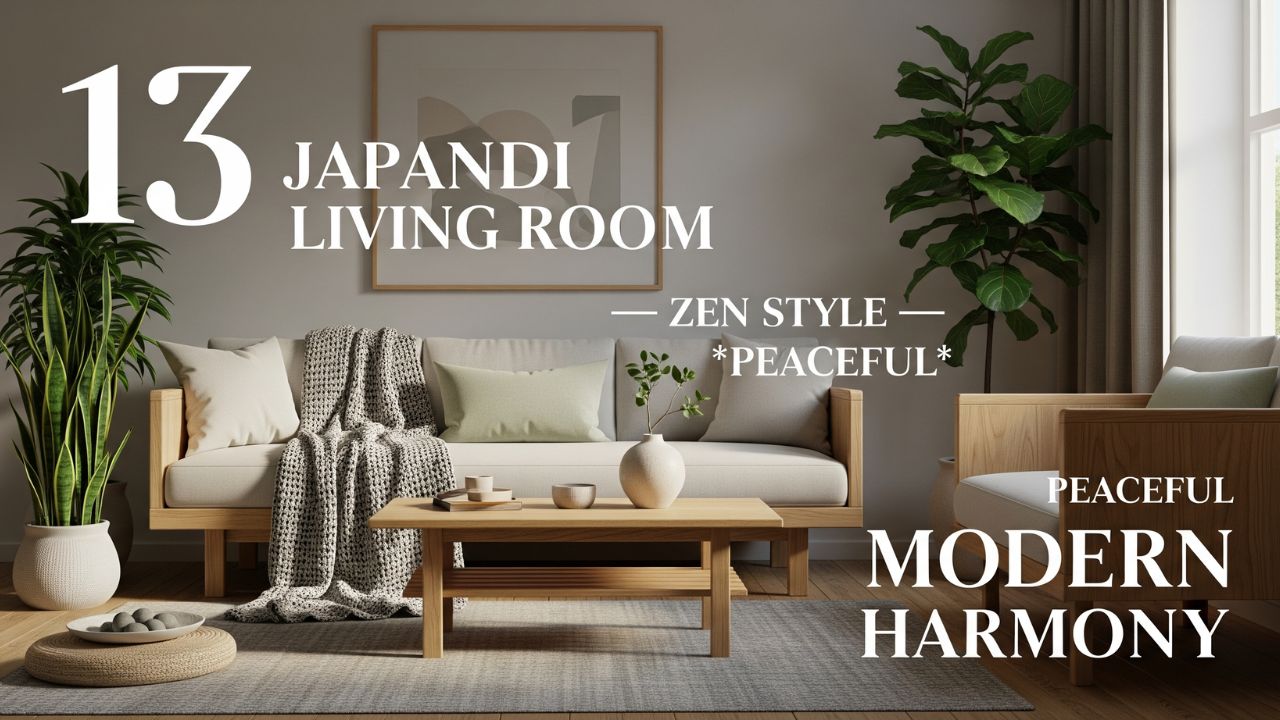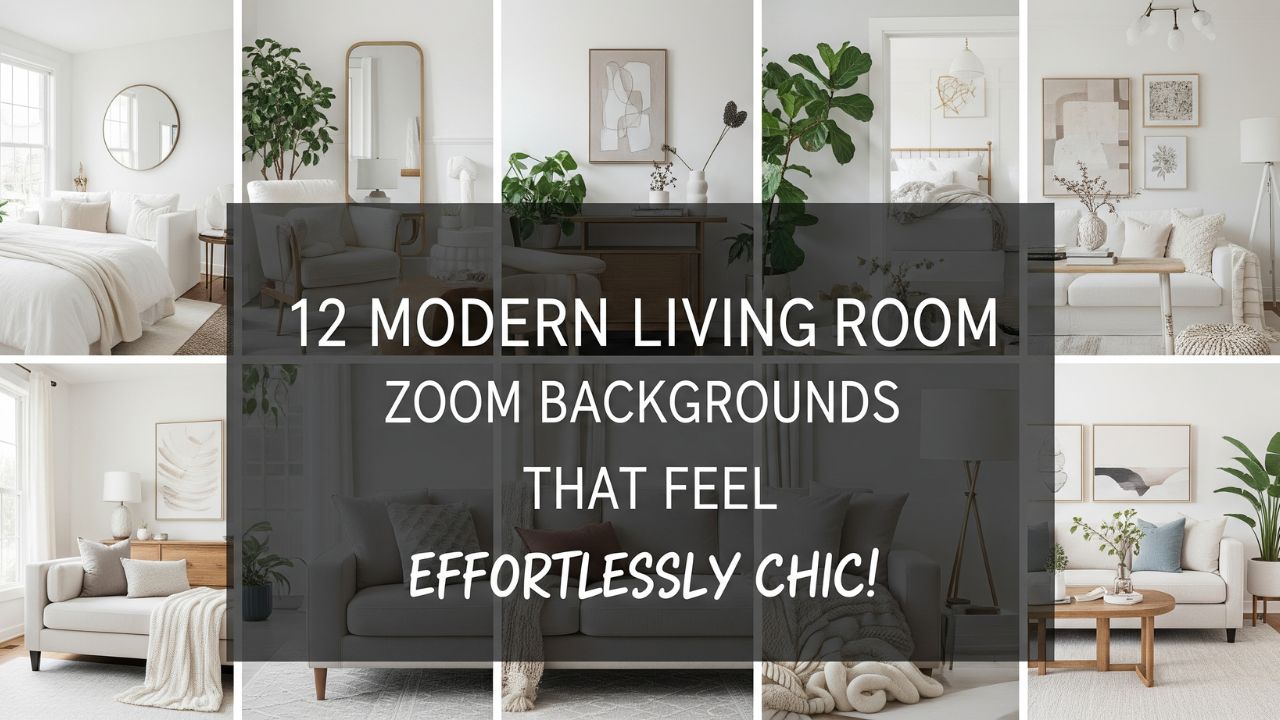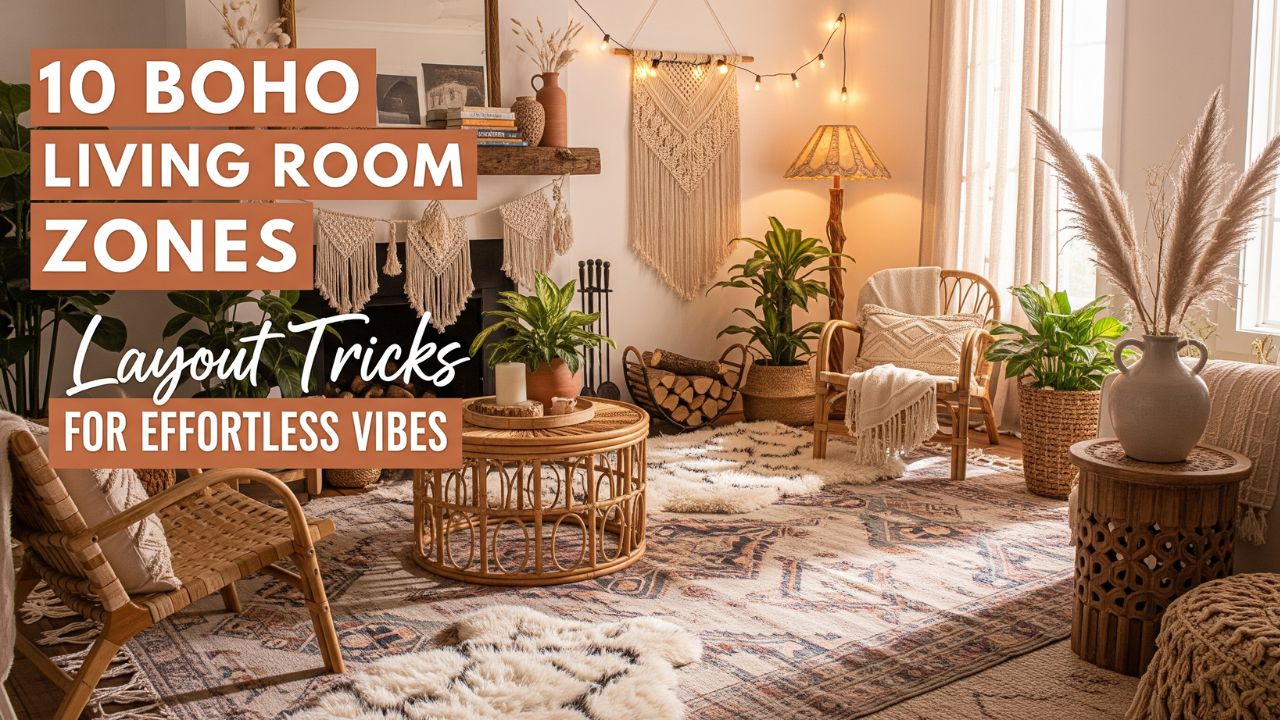Imagine walking into a space where every object feels intentional, every corner breathes calm, and the atmosphere whispers serenity. That’s the quiet magic of a Japandi living room — a design style that fuses the minimal elegance of Japanese interiors with the cozy functionality of Scandinavian design.
This harmonious blend isn’t just a trend — it’s a lifestyle. Japandi encourages living with less, but better; valuing quality, nature, and mindfulness over excess. It’s the design language of peace — perfect for those who crave balance between simplicity and warmth.
Do you know? The term Japandi first started trending around 2016, but its roots date back to the 19th century, when Japan opened trade with the West — inspiring the Nordic fascination with wabi-sabi (the art of imperfection) and minimalism.
Let’s explore 13 inspiring ideas to help you craft a Japandi-style living room — a peaceful retreat that radiates modern harmony.
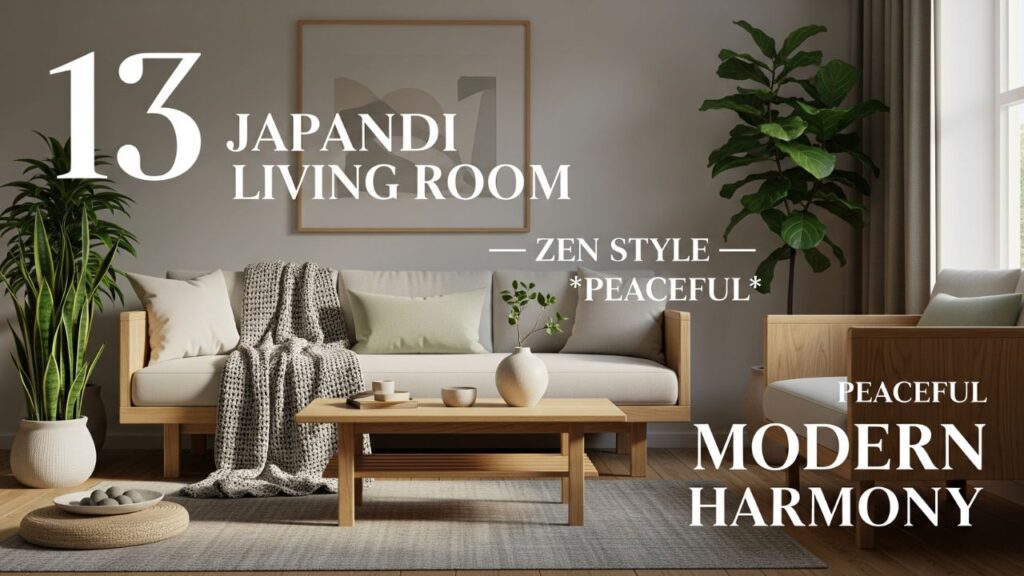
Table of Contents
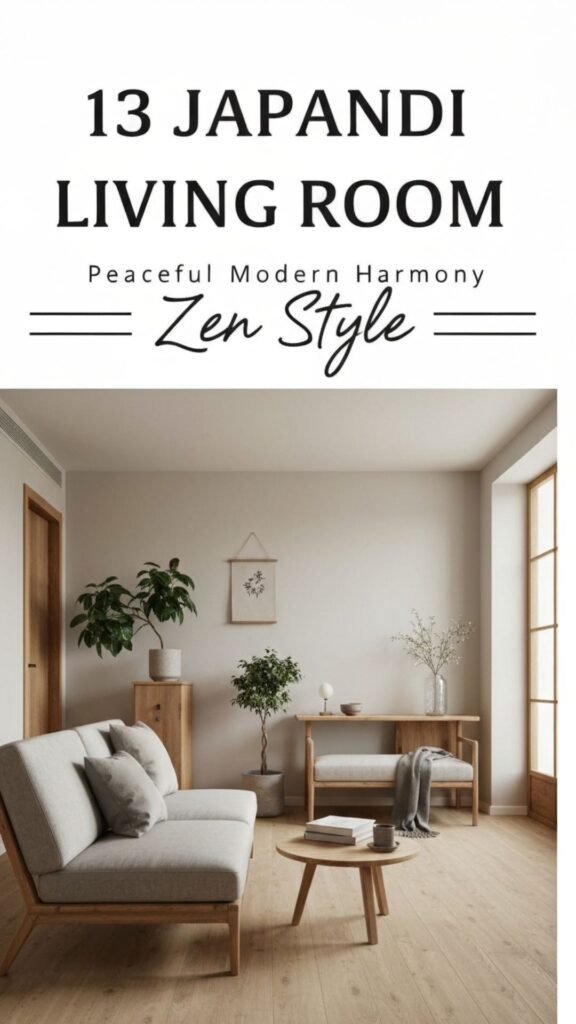
13 Japandi Living Room Zen Style
1. Embrace Minimalism: The Beauty of “Less Is More”
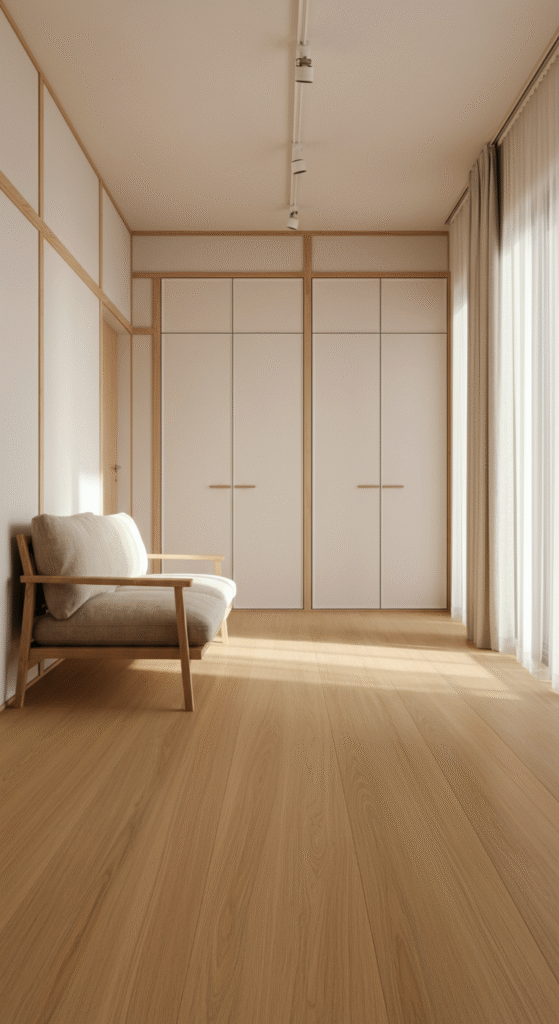
At the heart of Japandi design lies simplicity. Every piece of furniture or décor item should serve a purpose — function first, beauty second.
Start by decluttering. Remove anything that doesn’t add value to your space, either emotionally or practically. A minimal room allows light to flow freely and gives your mind a sense of openness and calm.
Interesting fact: In Japanese philosophy, “Ma” represents the space between objects — it’s not emptiness, but a deliberate pause that lets energy circulate. This concept makes minimalism not about “lack,” but about “balance.”
2. Choose Natural Materials
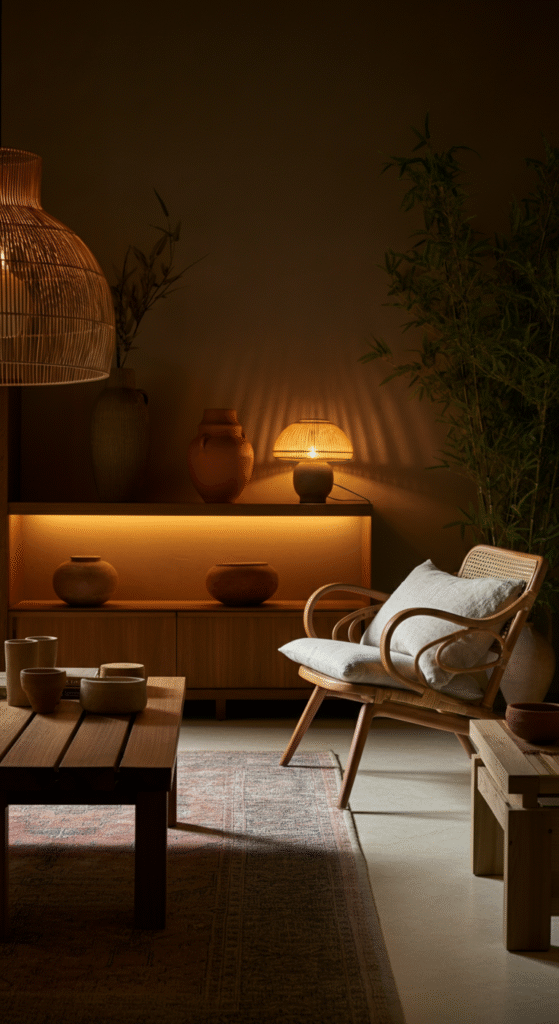
Japandi interiors thrive on organic elements — think raw woods, bamboo, rattan, cotton, linen, stone, and clay. These materials add texture, warmth, and a tactile connection to nature.
Opt for furniture made of light oak or ash (Scandi influence) and darker walnut or cedar (Japanese influence). Mixing these tones adds depth while maintaining harmony.
Do you know? In traditional Japanese homes, materials like paper screens and tatami mats were chosen to harmonize with the seasons — cool in summer, warm in winter. Japandi honors this tradition by embracing adaptable, sustainable materials.
3. Neutral Color Palette with Depth
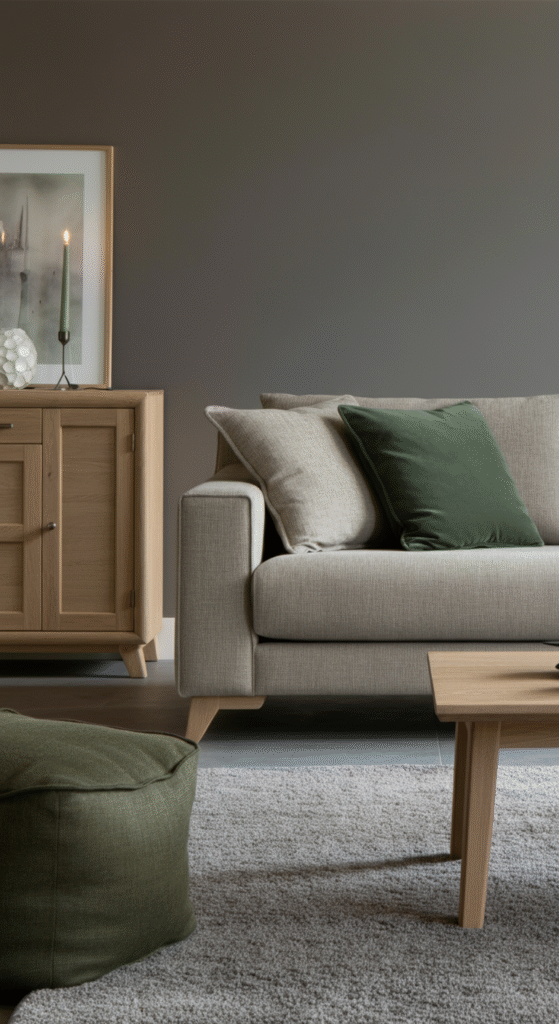
A Japandi living room’s color scheme often feels like nature itself — soft beiges, stone greys, muted greens, and earthy browns. Add warmth with creamy whites and a touch of black for contrast.
The key is balance. Scandinavian design leans toward airy whites, while Japanese interiors favor earthy, grounded tones. When blended, they create a neutral palette that feels both clean and comforting.
Tip: Use texture — not color — to create visual interest. Linen curtains, wool throws, or a jute rug can bring life to a neutral room without overwhelming it.
4. Low-Profile Furniture
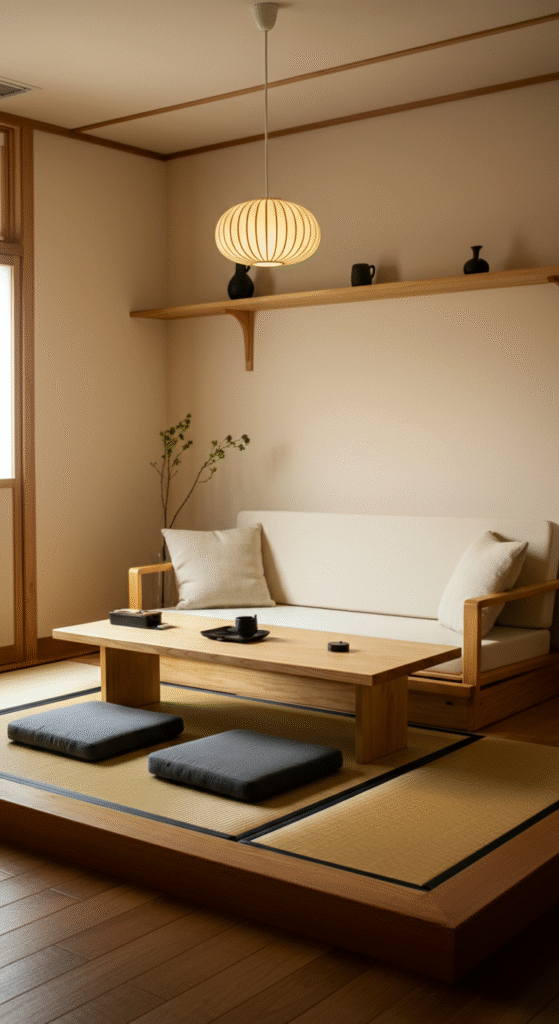
A distinctive trait of Japandi design is furniture that sits low to the ground — inspired by Japanese floor culture.
Think low coffee tables, platform sofas, and minimal wooden benches. This setup creates a grounded feeling and enhances the flow of air and energy.
Interesting fact: Sitting closer to the ground is believed in Japanese culture to foster humility and connection — both with people and the Earth itself.
5. Incorporate Wabi-Sabi Philosophy
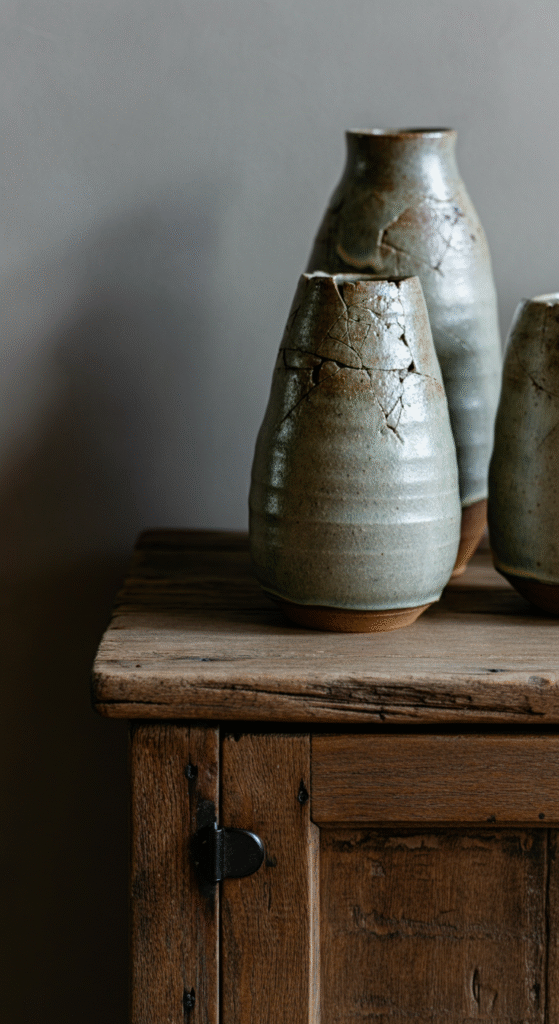
Wabi-sabi celebrates imperfection, transience, and authenticity — the beauty of “perfectly imperfect.”
Include handmade ceramics, slightly uneven pottery, or weathered wooden textures. These details bring a soulful quality to the space and remind you that beauty lies in simplicity and authenticity.
Myth-buster: Many people think wabi-sabi is about things looking old or worn-out. In truth, it’s about appreciating the natural cycle of life and embracing age as part of beauty.
6. Let Natural Light Flow
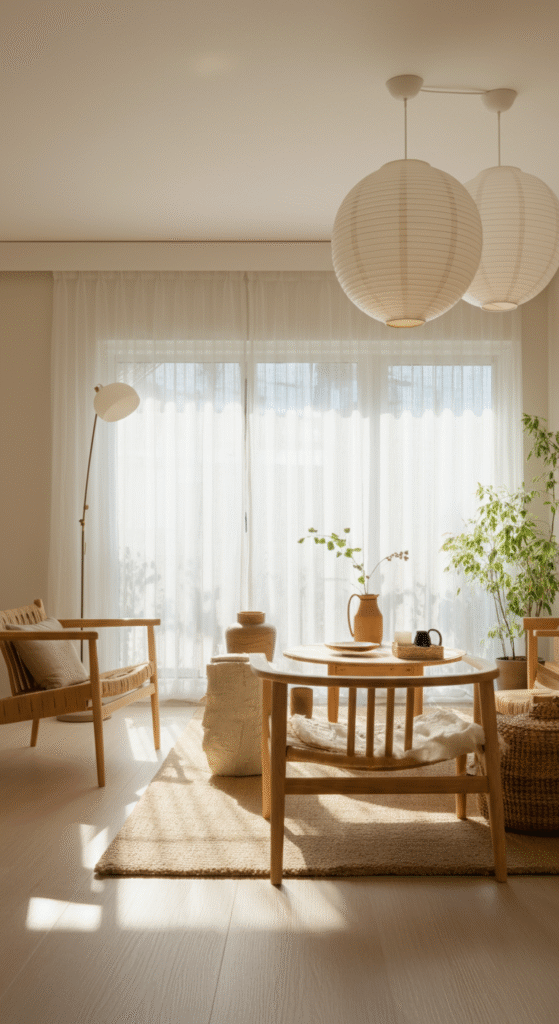
Light is a core component of Japandi design — not just for brightness, but for mood.
Large windows, light-filtering curtains, and open layouts help flood your living room with gentle, diffused daylight. Use sheer fabrics and avoid heavy drapes that block the connection to the outdoors.
If natural light is limited, use warm, ambient lighting — like soft pendant lamps, paper lanterns, or diffused LED strips — to mimic a sunrise glow.
Do you know? In Japan, the play of light and shadow (komorebi) — sunlight filtering through leaves — is considered an art form. It’s a poetic reminder to appreciate fleeting beauty.
7. Add Greenery for a Breath of Life
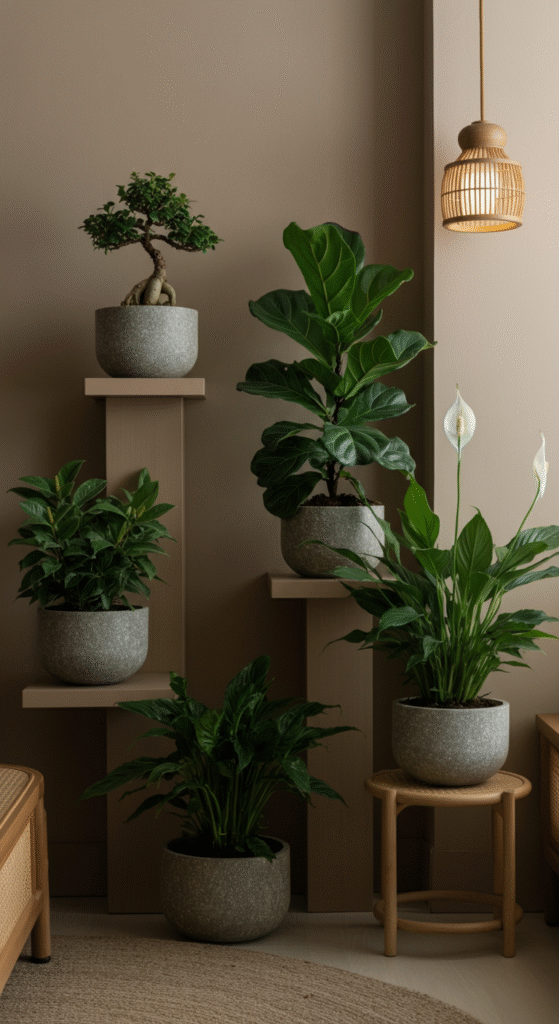
Nature is essential in Japandi interiors. Bring in potted plants, bonsai trees, or leafy indoor greens like fiddle figs, peace lilies, or snake plants.
Use minimalist planters — ceramic, clay, or stone — to keep the look refined. One or two thoughtfully placed plants can make a stronger visual statement than a clutter of small ones.
Fact: Both Scandinavian and Japanese homes use plants not just for aesthetics but for emotional well-being — studies show greenery reduces stress and boosts creativity.
8. Layer Textures Thoughtfully
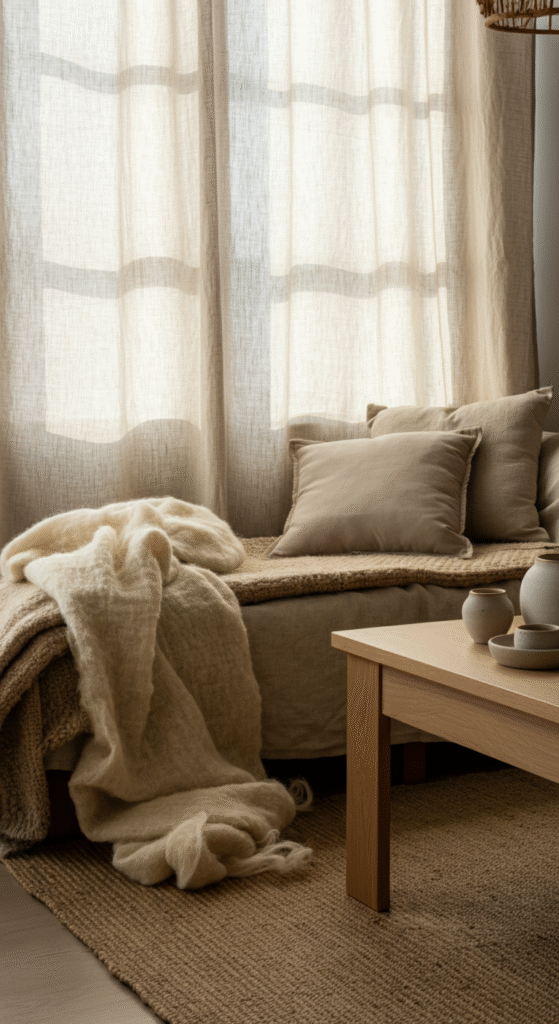
Texture is what makes a minimal room feel alive. In a Japandi living room, combine soft textiles with organic materials for cozy balance.
Pair a smooth oak table with a woven rug, a linen sofa throw, or a wool cushion. Avoid shiny or synthetic finishes — matte and natural are key.
Myth: Minimalist interiors are “cold.” In Japandi, warmth comes from contrast — rough wood beside smooth ceramics, stone floors paired with soft cottons — a subtle dance of textures that adds soul to simplicity.
9. Focus on Craftsmanship and Quality
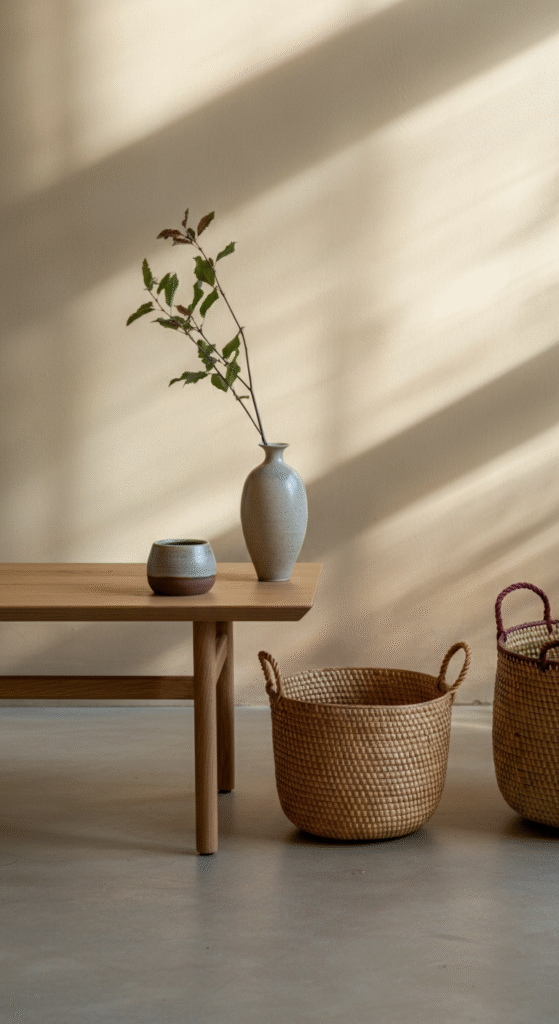
Japandi design honors the artistry behind every object. Instead of mass-produced décor, choose handcrafted pieces that tell a story — artisanal pottery, handwoven baskets, or custom wood furniture.
Quality over quantity is the rule. Invest in fewer, well-crafted items that will last decades. This mindful approach reflects both Scandinavian durability and Japanese respect for craftsmanship (takumi).
Do you know? In Japan, the concept of Monozukuri means “making things with spirit” — an approach that values care, precision, and dedication in every creation.
10. Declutter with Smart Storage Solutions
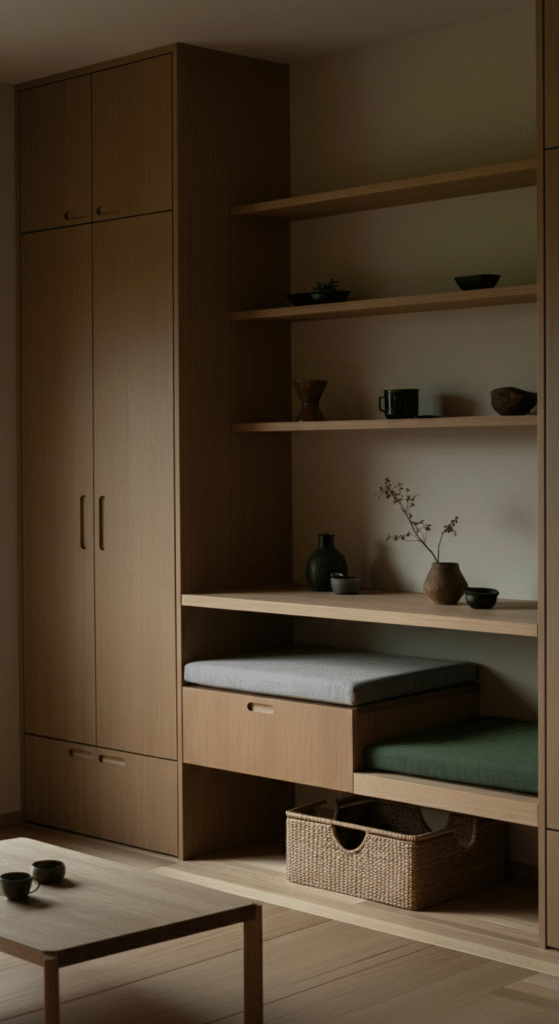
Clean lines and uncluttered spaces are essential to Japandi harmony.
Use sleek wooden cabinets, hidden shelves, and multifunctional furniture to maintain order. Scandinavian design excels in practical storage, while Japanese aesthetics keep it discreet.
Example: A bench that doubles as a storage chest, or floating shelves that showcase minimal art and ceramics. The goal is a calm, clutter-free environment that encourages mindfulness.
11. Include Subtle Cultural Accents
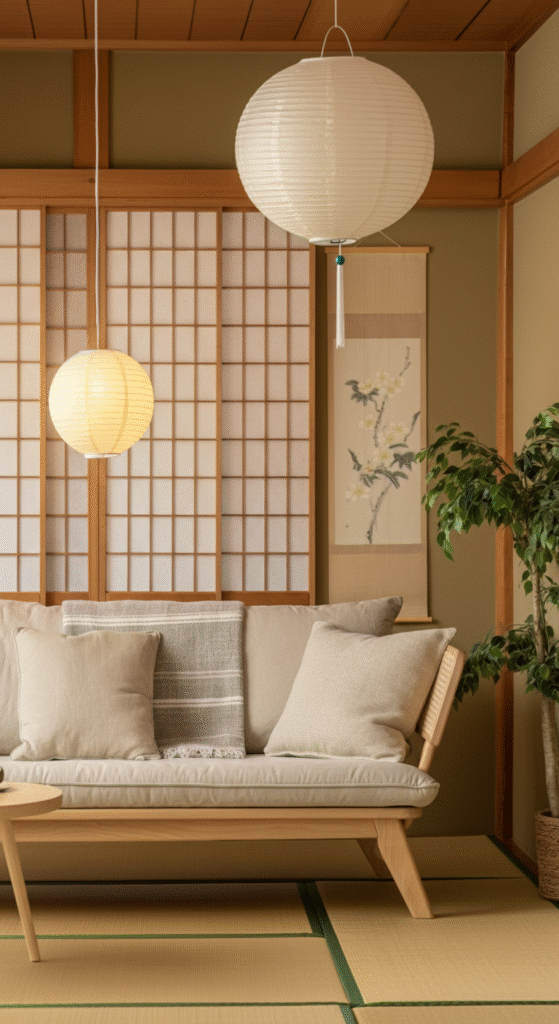
To make your living room feel authentic, incorporate subtle cultural elements from both traditions — without overdoing it.
A Japanese shoji screen, a simple paper lantern, or a bonsai tree can blend beautifully with Scandinavian wall art, a knitted throw, or minimalist wooden bowls.
Avoid mixing too many motifs. Japandi is about cohesion — not contrast. Each element should feel like it belongs to a shared story of calm and clarity.
Interesting fact: The Japanese word shibui means an understated beauty that grows on you over time — much like how a Japandi room reveals new charm the longer you live in it.
12. Add a Zen Corner for Mindful Moments
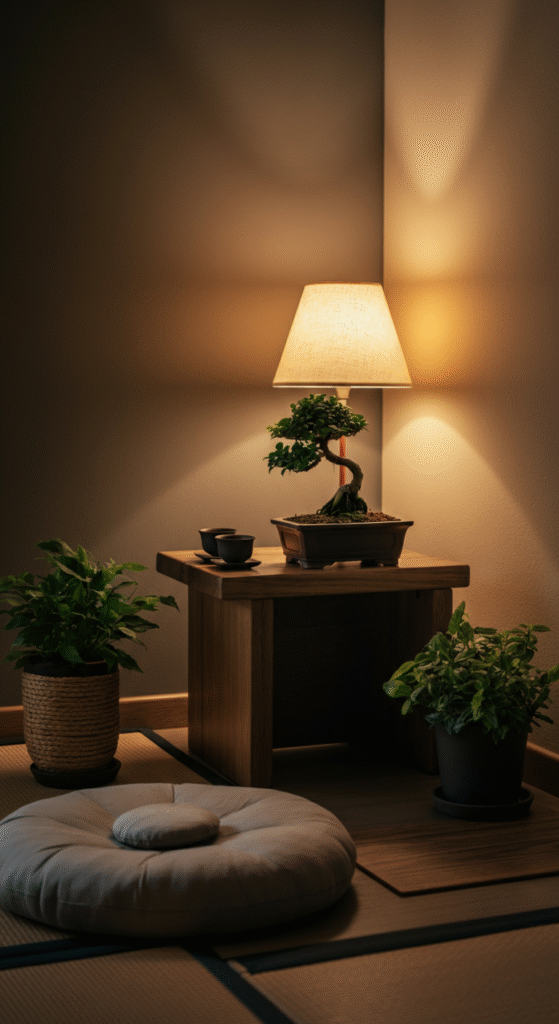
Dedicate a small corner for peace and reflection — a meditation spot, reading nook, or tea table.
Keep it simple: a floor cushion, a small plant, a ceramic vase, and perhaps a low lamp. This corner becomes a visual and emotional pause in your space — a reminder to breathe and slow down.
In Japanese culture, such spaces are known as tokonoma — alcoves designed for contemplation, often displaying a single flower or artwork. You can reinterpret this in your home with your own modern twist.
13. Balance Warmth and Serenity with Accessories
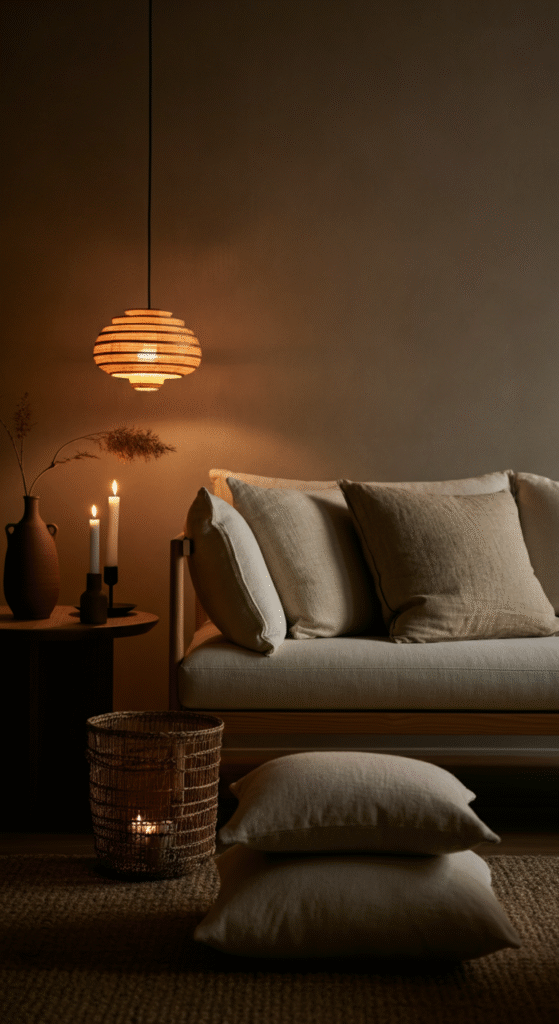
Accessories in Japandi interiors are minimal yet meaningful.
Use handcrafted vases, woven baskets, neutral-toned cushions, or a single piece of calligraphy art. Keep surfaces clean and uncluttered, so every item has purpose and presence.
Tip: Add candles or incense to bring in soft scents and gentle lighting — sensory elements that amplify the Zen experience.
Do you know? The Japanese tea ceremony was one of the earliest inspirations for minimalist aesthetics — it emphasized purity, mindfulness, and beauty in simplicity, values that echo perfectly in Japandi design.
Conclusion: Finding Peace in Modern Living
A Japandi living room isn’t just about furniture or color palettes — it’s about cultivating peace through intentional living.
In a world that moves fast, Japandi invites you to slow down. It reminds you that beauty lies in balance — between light and shadow, form and function, simplicity and comfort.
By merging the timeless wisdom of Japanese Zen with Scandinavian warmth, you create more than a stylish interior — you build a sanctuary of serenity, mindfulness, and effortless modern harmony.
Your living room becomes not just a space to exist, but a space to truly be.
Frequently Asked Questions (FAQs)
What colors are best for a Japandi living room?
Neutral shades like beige, grey, taupe, cream, and muted earthy tones create the calm and balanced palette Japandi is known for.
How do I make my living room feel more Japandi?
Declutter, choose natural materials, keep furniture low, add plants, and embrace handmade or imperfect décor pieces.
Is Japandi the same as minimalism?
Not exactly. While minimalism focuses on reduction, Japandi adds warmth and texture, blending simplicity with coziness.
Can Japandi style work in small spaces?
Absolutely. Its clean lines, multifunctional furniture, and light tones make small areas feel more open and peaceful.
